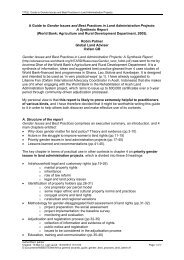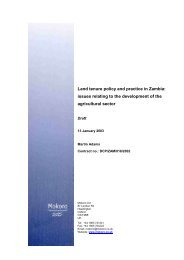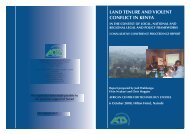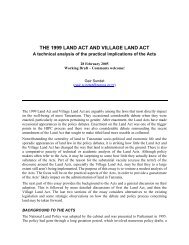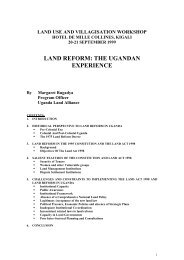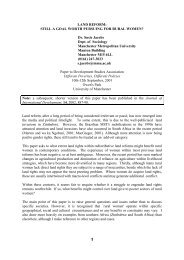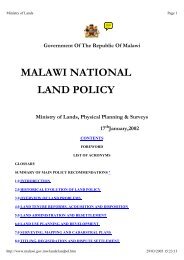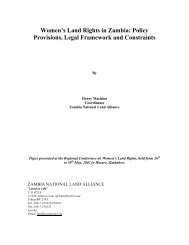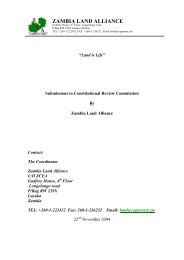Download - Mokoro
Download - Mokoro
Download - Mokoro
- No tags were found...
You also want an ePaper? Increase the reach of your titles
YUMPU automatically turns print PDFs into web optimized ePapers that Google loves.
30where possible, to increase state revenue from agriculture – in South Africa they hadserved the opposite purpose: to redistribute resources from the rest of the economy tothe commercial farming sector. State price control that maintained high maize pricesmeant a net welfare transfer from lower-end black consumers to white farmers producingmaize through the 1980s (van Schalkwyk 2003:127). However, deregulation ofmarketing was supported by better-off farmers and agribusinesses involved in secondaryagriculture, who lobbied to be able to market freely at the end of the sanctions era,resulting in the Kassier Commission. The Marketing of Agricultural Products Act of 1996confirmed the deregulation of marketing and established the National AgriculturalMarketing Council (NAMC) to advise on statutory measures to regulate agriculturalmarketing with some powers of intervention, including to fix prices and control imports,but was generally disinclined to use them. By 1998, all control boards had beenprivatised and this new marketing environment saw a proliferation of private marketingand export agents.In the place of price control, the South African Futures Exchange (SAFEX) wasestablished in 1988 as a futures market for key grain staples: white and yellow maize,wheat, soya, sunflower seeds, and so on. This is now the key “price discoverymechanism” for certain commodities in the post-marketing control era to provide “pricerisk management”, and was expected to provide price stabilisation. However, the FoodPrice Monitoring Committee found it led to price volatility and overshooting on the basisof perceptions, that large players were able to manipulate prices, it was inaccessible tosmall producers and millers, and was likely to lead to concentration in medium to longterm (NDA 2003:16).Outcomes of deregulationThe commercial sector is now a mixed picture. Certain commodity sectors are in crisis,including maize, but there is increased efficiency (narrowly defined), through verticalintegration and elaboration of privatised value chains – from production to marketing,processing and packaging, distribution and consumption. As a result, agribusiness hasthrived at the cost of smaller and poorer white farmers, who are unable to takeadvantage of economies of scale outside of primary production. This means alsochanged dynamics of vested interests in agriculture. Previously, it was assumed thatblack farmers and consumers would have common interests, but a growing alliance inorganised agriculture, through the Presidential Working Group on Agriculture, has forgedcloser relations between agribusiness, white and black established farmers, togetherwith the increasingly important commercial banks.As a result of both the process of deregulation and the liberalisation in the internationaltrade of agricultural goods, major changes have taken place in all areas of agriculture.Total agricultural output grew 27% between 1995 and 2002. Nationally, South Africa isself-sufficient in field crops and horticulture and nearly (97%) in livestock. Producerprices grew 79% in this period, but input costs grew faster, bringing about a “cost-pricesqueeze” in some sectors. Yet on the whole agriculture is doing well: gross income wasR42 billion in 2002 and net income rose from R7 billion in 1994/95 to R23 billion in2002/03. Capital formation has doubled since 1994, and the contribution of agriculture tothe GDP has increased slightly from 3.2% in 2002. The rapid growth in exportsoutstripped the growth in imports from 1994 to 2002, with imports rising from R5 billion toPolicy Options for Land and Agrarian ReformProgramme for Land and Agrarian Studies, University of the Western Cape




